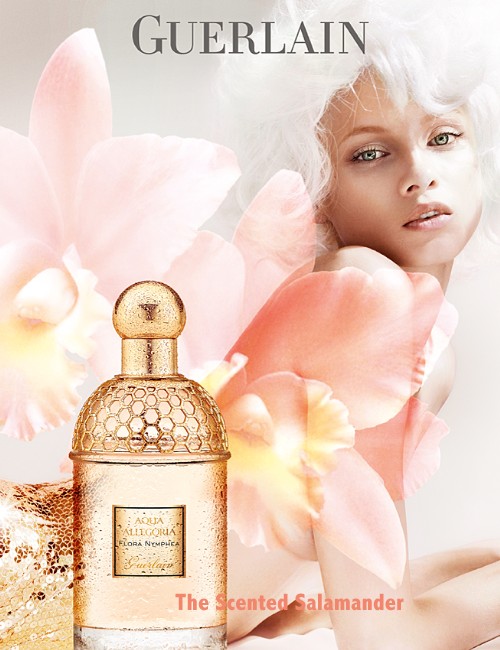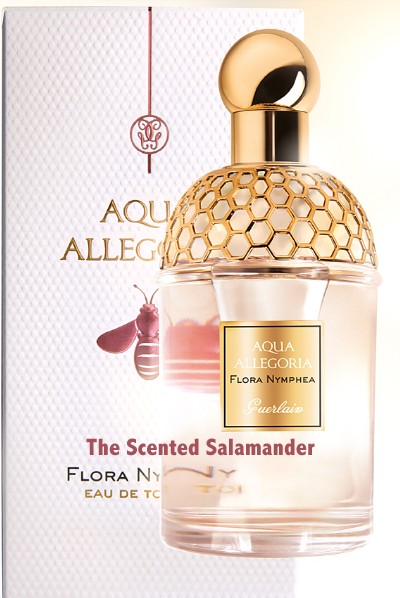Guerlain Flora Nymphea (2010): A Return to the Roots of Guerlain: Anglomania, Spleen, Belle Epoque and the Poetry of the Seasons {Perfume Review}

Flora Nymphéa is the latest annual addition to the Aqua Allegoria line by Guerlain, due to launch on March the 8th, 2010 in France. The perfume's inspiration rests on the scent of mock orange (seringa). It also benefited from an exceptional quality of orange blossom sourced from Calabria from a three-generation family of producers, per the press materials.
As noted previously, the name for the fragrance this time calls attention to a more complex imagery than that of the pairing of two main ingredients: Figue-Iris, Laurier-Réglisse, Angélique-Lilas or Tiaré-Mimosa... On a semiotic plane, it is closer to such titles as Herba Fresca, Anisia Bella, Winter Delice and Flora Nerolia although it seems to put emphasis on an added poetic tonality, an impression which is reinforced by the advertising campaign featuring a nymph (model Anna Selezneva) out of a fairy-tale, and not simply a nymphea flower. The nymphea arguably appeared recently on the Guerlain Mitsouko Fleur de Lotus bottle in 2009.
If Mitsouko Fleur de Lotus was a return, to my nose, to a more authentic rendition of Mitsouko paradoxically created through different paths, Flora Nymphéa conveys a similar impression: that of a more original Guerlain marrow found inside a new skeleton supporting fresh flesh dressed up in new guises but done in the same technique of vaporous, vague flou as with some of the early Guerlains.
If the lotus and nymphea are the signs, inspirations and mental aids that Guerlain use to recapture their ability to compose Impressionist perfume-poems, so be it.
Flora Nymphéa is a delicate, romantic, less aquatic-and-new-freshness composition than we have come to expect from contemporary perfumes as well as most of the Aqua Allegoria line in particular. There is also more of the interesting jolie-laide harmony found in the antique Guerlains...

From the initial instants, you can gauge that the composition is more ambitious than most Aqua Allegorias's, more like a complete perfume, and one made in a turn of the 20th century Guerlain spirit at that. The fresh reworkings and signature to which this line is dedicated since Herba Fresca (1999) has been rethought here, evoking the sensation of freshness in a more abstract manner through the creation of springtime and summertime sensations rather than resting on the more literalist 1990s fascination for Calone-laden and Hedione-infused scents and their subsequent legitimate offsprings. The watery signature recedes in the background to leave room to allusive associations and images.
Perfumer Thierry Wasser said that he had eschewed following the path of the eau de Cologne skeleton, which had been done several times by his predecessors.
I usually concentrate on my olfactory impressions first and then read the press materials, whenever available. Sometimes, I even have to force myself a little. In this case, my perception of one of the meanings of the scent corresponds to the intent of the perfumer. Thierry Wasser did explicitly point out that he preferred to focus on the "Allegoria" part of the equation rather than on the "Aqua" part. This can readily be felt in the perfume. The signature is more ample and complex than for other Allegorias. It remains one in as much as the drydown is light and the two seasons to which it pays homage normally, (except for Winter Delice) spring and summer, can be recreated in our minds.
Flora Nymphea, as I already said in an earlier tweet, is a return to Belle-Epoque Guerlain, to the pastel, fresh, bucolic and fresh renderings of this old-world and romantic vignette in particular, Après L'Ondée (1906). I think of an atmosphere like that of Après l'Ondée but it does not smell like it; it is just as poetic and introspective. I see this as a return to impressionistic, contemplative Guerlain removed from the din of daily affairs and finally able to create again aloof dreams for women and men. One recognizes la patte de Thierry Wasser in a supporting quote from Idylle (see Part 1 and Part 2), only slightly muskier
Flora Nymphea aims more for a sense of eternity because it aims more at poetry. It refuses to be content with the standard functional aims of a spring and summer perfumes: to quench, to refresh, to let you breathe easier in the light then heavier air.
Anglophilia and Spleen at Guerlain
I want to go back to the image of the water nymphea which here is more like a Monet nymphea: you contemplate water but you do not smell it. The nymphea may well be the needed symbol to tap into the vagueness and wistfulness, the delicious spleen of some of the late 19th-early 20th century Guerlains. Spleen, cool spleen is very good for Guerlain.
I use the word spleen in the archaic and Baudelairian sense of melancholy, not anger. It gave the house three enduring masterpieces: Jicky, Après L'Ondée, L'Heure Bleue. Spleen is colored blue and bluish at Guerlain. Last year it tinted the bottle of Mitsouko Fleur de Lotus and now the jus of Flora Nymphea. Spleen means pausing to reflect. It is opposed to the fugacity of mood and the whims of bespoke fragrance which was the first main professional activity of the founder of Guerlain as a perfumer. It implies a consciousness about one's own house's signature and the work that needs to be done to make it gain in personality, not lose it.
Counterbalancing the current of spleen, there is an inherent French joie de vivre, at times hush hush, capable of stillness, more septentrional: what I like to view as the English influence on Guerlain since the days when Pierre-François-Pascal went to London to study chemistry and perfumery. Later, when he established himself in Paris in 1828, his first business activities were to import English products. From merchant and taste-maker, he evolved to being a more full-fledged perfumer. There is a patent brand of anglophilia in the history of Guerlain which would need to be explored more. The movement debuted during the mid-18th century in France and has had long echoes in French culture. At Guerlain, the strain is still perceptible as a conscious one in Jicky and is more sublimated, to me, in Après L'Ondée. The latter has often made me think of a stroll taken by a Jane Austen heroine in the damp English countryside just after the rain. Anglophilia is still quite clearly traceable in Habit Rouge's homage to a hunting party. Author Susan Irvine writes in Perfume: The Creation and Allure of Classic Fragrances,
"At the time [1828], anything English was hugely fashionable in Paris, and Guerlain, who had studied chemistry and perfumery in England, imported English perfumes and cosmetics. Soon, however, he was experimenting with his own products, manufactured in a nearby workshop."Yet, even though Guerlain would start to create on his own, he would still make annual trips to England, as reported in a 19th century source from the 1830s.
How it Smells
There is mandarine on the open, slightly raspy white musks, honey, orange blossom. The latter note offers its natural animalic and leathery sides, its pungent thrust. It is not the orange blossom water of babies scents which are so popular in France but its more intoxicating incarnation, meant not to soothe but to inebriate you and possibly shock you although not in this case. Madame Celnart in her Manuel des Dames published in 1833 was not fooled and put orange blossom on an equal footing with tuberose, musk, and amber. It was unlady-like and provocative (My own 1837 edition does not show this passage, so I am quoting from the Susan Irvine book.)
Here, the orange blossom note has been left to reveal its animal nature, but at a level still more disturbing to bees than to humans.
The perfume offers an unusual, contrapunctal opening, bluish-seeming. Its personality is romantic and soft but also slightly discordant and pungent. I think words like: hazy, misty, dusty veils, wings of butterfly, bluish powder.
There is an impression which makes me think of musky herbs exhaling and reaching a peak of intensity in their scents before drying down in the sun. I could almost hear the buzzing of bees nearby, attracted to these overheated, excited exhalations. It smells of the immense intensity of summer when the world is still and quiet and everyone in the summer house in the countryside is taking a nap.
The haziness must be due to the powderiness of iris and of a subdued spicy carnation accord with an ambergris undertone. I pick on a hyacinth note. There is a grapey Methyl Anthranilate nuance which contributes to the light dissonance of the composition. There is the characteristic fleeting sensation of freshly cut grass thanks to cis-3-hexenal. But all this is mingled rather than multi-faceted and brought to the front of the sensations.
I am amazed to see how perfumer Thierry Wasser manages to disorient you while using classical notes from the repertoire of perfumery. This is an example that shows me that in a sense it is not very meaningful to break down a perfume into its constituent elements because a successful blend is meant to be more than the sum of its parts.
Flora Nymphea is a return to a romantic femininity where the woman is like a flower and wears a corsage. There are hints of lily, gardenia with cheese-like traces, iris, a rather pronounced hyacinth with a puff of smoke. The millefleurs aspect of Idylle is present.
Analyzing the perfume makes me focus more on the materials and makes me lose the precious perspective I need to day-dream and leave this moment for another one. I can and do appreciate the materiality and sensuality of the honey and orange blossom accord here which is like a ribbon of lush goodness, but then I become more like a bee and less like a human with imagination. I revel in this nectar and I lose at the same time my sense of space, memory, affectivity and time-travel.
So I try to distance myself again and I try to go back to this sensation of a summer garden by a quiet house, a breathing, sighing house in the countryside, where all your loved ones are sleeping in the lull of the afternoon, including the cats, the dogs, but never the bees which are buzzing away and busy gathering nectar. The scent of the garden is the only other disturbance, magnified by the silence and the sun. Some fruits have dropped on the ground and are rotting by the overheated and excited flowers, or there is apricot compote on the wooden garden table turning sticky sweet and the cobblestones in the courtyard smell dusty.
The composition is both ethereal and earthy like the art of perfumery.
Finally, Jean-Paul Guerlain has let out that the next Aqua Allegoria might be inspired by tobacco. He has some ideas about it already.
Flora Nymphea is priced at 68€










Hmm, begins with a sharp but sweetish orange blossom(honey maybe), though some green note also. Then, resolves into more subdued green and floral form. All above occurs within 2-4 minute window( and the orange blossom is already a distant memory by now). And the eventual drydown is where it disappoints; it turns into a nondescript faint leafy chypre. Oh, why is AA series not that impressive? An adequate summer fragrance, nothing to write much home about.